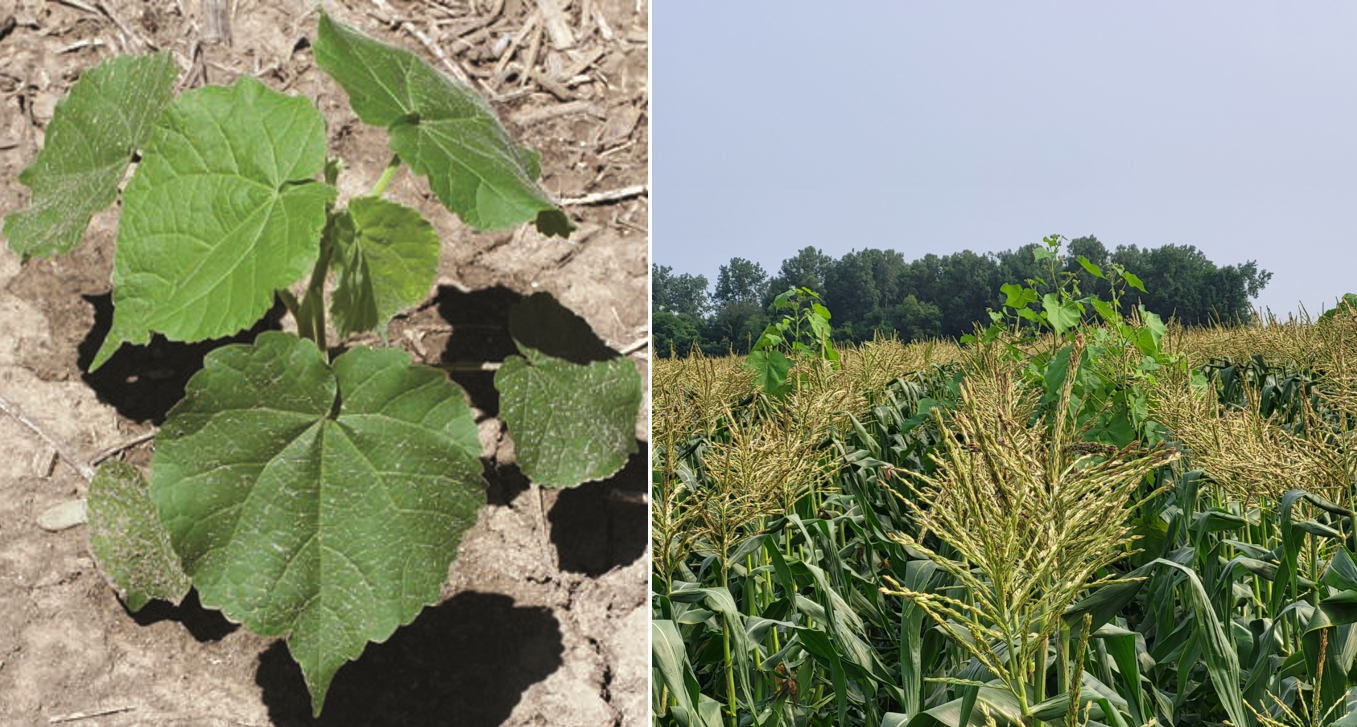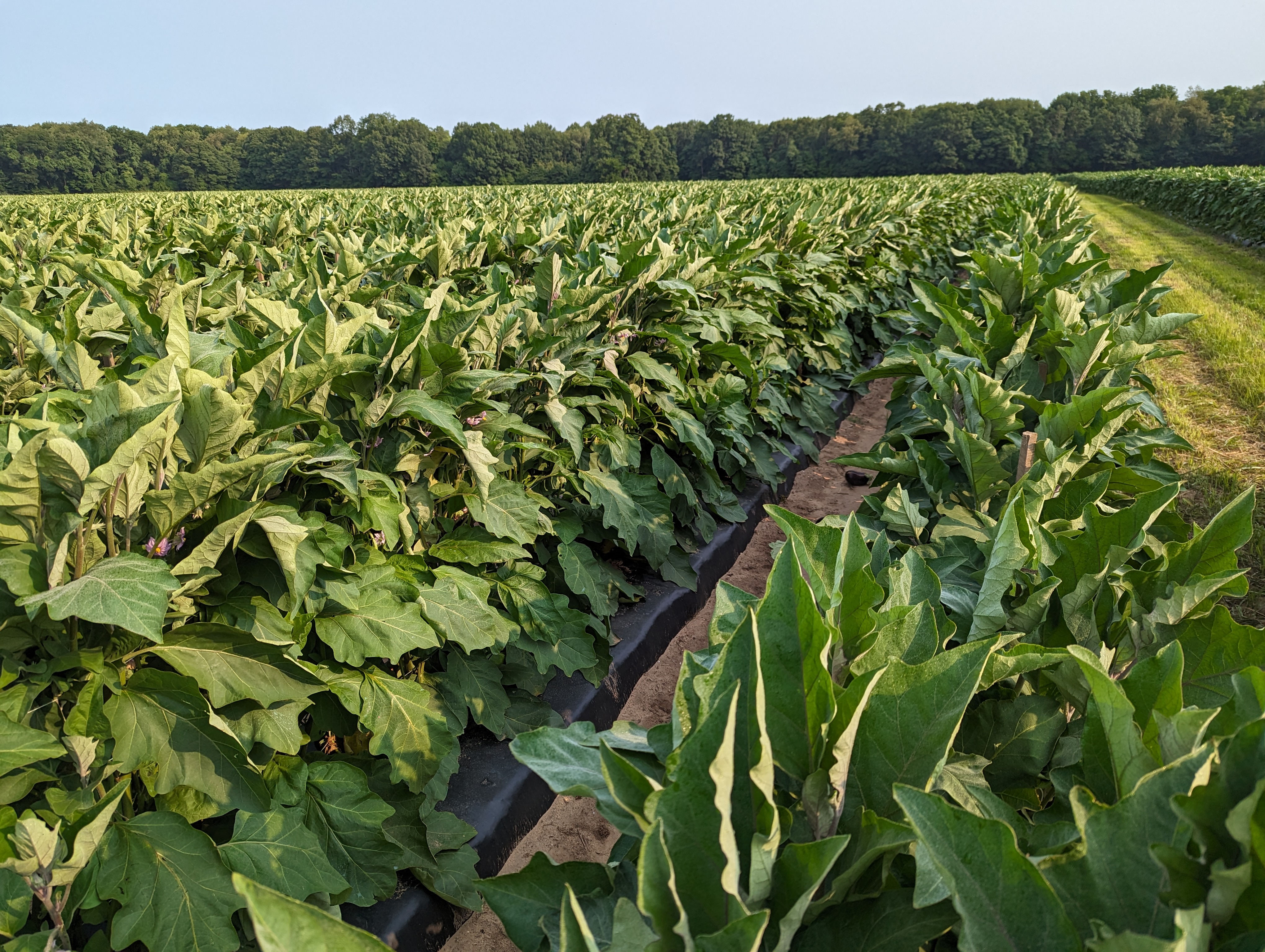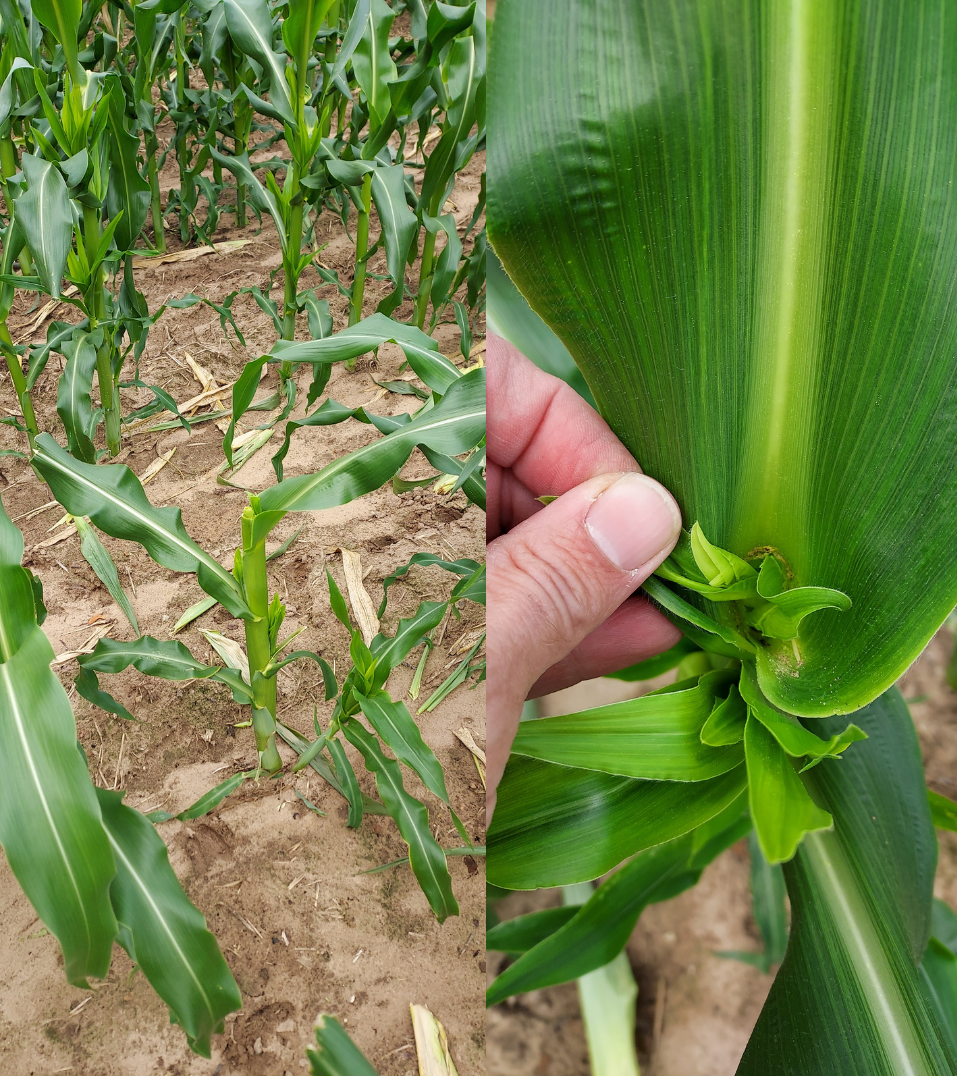Michigan vegetable crop report – August 9, 2023
Growers are controlling late-season pests and ensuring successful harvests.
Weather
Watch Jeff Andresen’s weather update here.
This year we are relatively cool during what’s normally the “dog days” of summer. Mean precipitation totals for the past week ranged from 0.5 inch to over 1 inch in the east, though northwest Michigan was missed again.
The forecast calls for:
- Precipitation for the next week is forecast to total 0.75-1 inch for much of the state.
- Fair, warm and dry most areas Wednesday, Aug. 9. Scattered showers and thundershowers developing this afternoon in the northwest, spreading southeastward into lower Michigan this evening and Thursday, Aug. 10, especially south.
- Showers and thunderstorms developing once again west Friday afternoon and spreading east Friday evening and overnight into Saturday. Mostly fair, dry and cooler Sunday with showers possible again by Monday.
- High temperatures from the low to mid-80s Wednesday cooling slightly to the mid- to upper 70s F late this weekend. Low temperatures generally in the mid- and upper 50s F.
- Medium range outlooks generally call for near to below normal mean temperatures and near to above normal precipitation totals through next week followed by gradually warmer and drier weather later in the month.
Weed of the Week
Velvetleaf (Abutilon theophrasti) is a summer annual weed found in many farm fields. It is identified by its heart-shaped, soft textured leaves and large seed capsules ringed with pointed segments. The seeds themselves have a hard seed coat that makes them resistant to decay and contribute to their longevity in the soil. Velvetleaf begins to emerge early in the season and has a fairly prolonged emergence window, making it an easy weed to miss with management practices. Velvetleaf is tolerant of sub-optimal growing conditions like drought, overly wet soils, shade, and field compaction, giving it a competitive advantage over many crops.
Common pre-emergent herbicides like Command (clomazone), Goaltender (oxyfluorfen), Sandea (halosulfuron), Spartan (sulfentrazone), Tricor (metribuzin), Callisto (mesotrione) and Chateau (flumioxazin) will provide good control. Many of these products will also have good post-emergence activity. Vegetable crops that mature quickly and are harvested earlier in the season like snap beans or cucumbers can help with timely elimination of escaped velvetleaf plants and managing weed seed production, as most velvetleaf begin to set seed later on in the summer.

2023 MSU Extension Southeast Michigan Farmer Survey
MSU Extension is pleased to announce our 2023 Southeast Michigan Farmer Needs Assessment Survey. This survey will gather information about your farm and your potential interest in learning more about various farm-related topics. The information gathered will inform future programs and educational opportunities offered by MSU Extension educators for agricultural producers in southeast Michigan. This survey will take approximately 10 minutes to complete and is accessible at the link below:
Take the 2023 MSU Extension Southeast Michigan Farmer Needs Assessment Survey!
Feel free to share the survey link with other growers. We welcome any participation in the survey in order to help Michigan State University Extension better serve its communities.
QuickBooks survey
QuickBooks is one of the most widely used financial software packages for farm financial records. It is a powerful tool but using it effectively for farm businesses can be confusing. MSU Extension is partnering with the University of Wisconsin and University of Nebraska to develop educational resources for using QuickBooks for farm records effectively and efficiently. It would be greatly appreciated if you would complete a short survey that will help us better understand what is desired for QuickBooks educational programming.
Crop updates
Asparagus
Between seven and 16 disease severity values accumulated between July 29 – Aug. 4 in 12 Oceana County asparagus fields MSU Extension and collaborators are monitoring. Read more about purple spot control in our June 14 report.
Now that cherry shaking is in the rearview mirror it could be time to think about a woody rascal, tree of heaven, a challenge in some Michigan fields. Tree of heaven may be mistaken for sumac. Tree of heaven has leaves with smooth edges while sumac leaves have teeth along their edges, like a sawblade. Control with systemic herbicides could be done any time from mid-July up until first fall color. One option is to target small-diameter shoots with glyphosate spot treatments to foliage as long as you can limit contact with fern. Larger diameter trunks could be targeted with a hack and squirt treatment. Cut stump application will not be effective as tree of heaven can resprout from suckers. Further, basal bark treatments will not work well with glyphosate. It is a water-soluble herbicide that will not penetrate the bark. Tree of heaven will likely resprout from suckers next spring; resprouts can be targeted with glyphosate, dicamba or other herbicides.
Read more about controlling tree of heaven here, but note this article focuses on non-crop areas, so not all products are usable in asparagus. Please talk about these application methods with crop consultants, who have good experience with what is safe, and not safe, in asparagus.

Tree of heaven could possibly move into asparagus either through its wind dispersed seeds, similar to maple tree seeds, or by root suckers. Either way, consider controlling it outside of asparagus fields.
Carrots and celery
Aphids have been well under control this year. Scouts report catching them in sweep nets but have seen few colonies on plants. Variegated cutworm captures have been steady. Celery leaf tiers were present in two locations over the past week. Scouts found caterpillars in one location, but they were in the top leaves where you normally find them. In hot years they can move to hearts.
Carrots are chugging along in west Michigan, with growers applying fungicides as we enter more dewy, disease weather. Some scouts have observed the beginnings of foliar disease. Read this past report about foliar disease control.
Electrical weeders are out and zapping weed escapes in carrots. Two passes over the field is generally beneficial, especially for larger weeds. Older/larger weeds tend to have woodier plant tissue, lower water content and more branching stems that avoid electrode contact and survive treatment, therefore repeated passes deal more damage and contact weeds that may have been missed by initial passes. Heavy weed infestations can also compromise control by overloading the equipment’s generator and reducing the efficacy of electrocution on individual weeds.
Cole crops and leafy greens
Diamondback moth is a common pest of many brassicas. Small caterpillars produce characteristic windowpane damage by scraping off the outer surface of the leaf and leaving small, slightly clear, thin areas behind. Older larvae chew holes in leaves.

Pyrethroids can work, but control may fail when local populations are resistant. Below are some non-pyrethroid, conventional insecticides that have provided consistent control across multiple trials. Note, Radiant, Exirel and Harvanta also have activity against thrips.
|
Active ingredient |
Tradenames |
Mode of action |
|
chlorantraniliprole |
Coragen, Besiege, Voliam Flexi |
Diamide |
|
cyclaniliprole |
Harvanta |
Diamide |
|
cyantraniliprole |
Exirel |
Diamide |
|
spinetoram |
Radiant |
Spinosyn |
|
enamectin benzoate |
Proclaim |
Avermectins |
Cucurbits/pickles
Processing zucchini in Green Bay colors (both yellow and green) were flying off of plants in west central Michigan recently, yields are good. Watermelon harvest has picked up on the east side. Harvest rolls on in other parts of the state.
Cucurbit downy mildew has been confirmed in eight counties to date: Saginaw, Monroe, Washtenaw, Ingham, Branch, Arenac, Bay and Berrien. Downy mildew spores were being captured through Aug. 1 in Muskegon and Allegan counties. So far it is all clade-2, which infects cucumbers, pickles and melons. See this report for details on fungicides. In northern Ohio, clade-1 has been reported on pumpkins.
Phytophthora continues to rear its head after rain events. Another source of infection is irrigation. It is tempting to keep plastic beds very moist to heal in transplants but this can also trigger Phytophthora if fumigants are not used.

Fruiting vegetables
Field harvest continues to pick up as plants mature further north. Prices per 10-pound box were still over $20 at some auctions. Disease severity values in weather models are racking up fast this week with warm days and long due periods. Early blight, Septoria leaf blight and anthracnose are the primary fungal diseases. Blossom end rot and sunscald are both easy to find right now on western and southern sides of plants, and on plants with compromised foliage, or huge fruit loads that swell out from under leaves. These injured areas can be entry points for secondary pathogens like Alternaria or Pythium to colonize and further reduce crop quality and plant health.


Onions
Early varieties of pungent yellow onions were being lifted last week at some locations in preparation for harvest, and sweet onion harvest for varieties like Candy was producing beautiful bulbs. Heavy rainfall can create issues as harvest approaches; inundated onions can be infected by bacterial pathogens residing in the soil, causing nasty rots. Harvesting onions before rainfall events can help minimize problems, but of course is not always possible.
On the insect and disease front, Lanante plus Warrior can provide a decent combination to finish out the thrips control season, when and where control is still needed. Read more information on Stemphylium control.
Sweet corn
Late plantings were going in last week for potential October harvests in southwest Michigan. The risk level on this is similar to early plasticulture plantings. The crop might not make it. Double crop soybeans are emerging above the sweet corn stubble in fields that have been machine harvested.
As of Monday, Aug. 7, west Michigan scouts report relatively low captures of earworm but higher numbers of western bean cutworm; the same was true in MSU Extension traps. To our south, corn earworm numbers started to increase in some southern Indiana and Ohio counties, and western bean cutworm was high but starting to decrease in Ohio. Insectforecast.com predicts a low risk of additional corn earworm migration with conditions most favorable Friday/Saturday, Aug. 11-12. It could be worth checking traps Saturday morning, especially if field corn pollination wraps up and sweet corn becomes the only game in town.
|
Corn earworm captures. Total in trap for week¹ (avg # per night²) |
|||||
|
Week |
Ottawa Co |
Oceana Co |
Monroe Co. |
Wayne Co. |
Berrien Co. |
|
8/9 |
- |
0 (<1) |
0 (<1) |
0 (<1) |
0 (<1) |
|
7/31 |
0 |
0 |
0 |
0 |
1 (<1) |
|
7/24 |
2 (<1) |
1 (<1) |
0 |
1 (<1) |
1 (<1) |
|
7/17 |
0 (0) |
0 (0) |
0 (0) |
1 (<1) |
- |
|
7/10 |
- |
0 (0) |
0 (0) |
0 (0) |
- |
|
7/3 |
- |
0 (0) |
3 (<1) |
0 (0) |
- |
|
¹Total number collected since last trap check. ²The total number divided by the number of nights since the last trap check |
|||||
Western bean cutworm continued to be present in some MSU Extension traps. You can scout for egg masses to determine if this pest is an issue. Read “Lep Monitoring Network Update #13 – WBC Numbers Remain High, Continue Scouting!” from Ohio State University for more information. Sweet corn that is just at pre-tassel is most attractive to egglaying females.
|
Western bean cutworm captures. Total in trap for week¹ (avg # per night²) |
||||
|---|---|---|---|---|
|
Week |
Ottawa Co |
Oceana Co |
Monroe Co. |
Berrien Co. |
|
8/9 |
- |
128 (18)3 |
12 (2) |
4 (<1) |
|
7/31 |
165 (24) |
15 (2) |
5 (<1) |
8 (1) |
|
7/24 |
112 (16) |
15 (2) |
- |
7 (1) |
|
7/17 |
- |
8 (1) |
- |
- |
|
7/10 |
- |
1 (<1) |
- |
- |
|
7/3 |
- |
0 (0) |
- |
- |
|
¹Total number collected since last trap check; ²The total number divided by the number of nights since the last trap check |
||||
Young western bean cutworm larvae were present in tassels in one location this week. This corn was just forming tassels during a period of high captures. Caterpillars come color coded for age, young ones found in the tassels can be stripey, but lose the stripes as they age. They also begin to wander out of the tassel down the plant as they get older. They can then bore into ears. They are different from corn earworm as multiple worms can bore into a single ear and happily munch (earworms cannibalize each other, so only the strongest survive). Further, they can bore into the side of ears, not just the tip. A pyrethroid application at row tassel may kill caterpillars as they wander down the plant, helping ensure they don’t slip down to developing ears. Otherwise, corn earworm sprays clean them up at silking.

Deer occasionally pull out tassels and decapitate corn, a phenomenon also known from field corn. The resulting damage looks really weird, like a corn plant that didn’t quite fulfill its destiny. These stalks may still have ears that develop. Varmints seem especially pesty this year.

On-Farm Food Safety
MSU and the Conservation Districts offer a program to visit your farm to go over your food safety program to provide critiques and comfort in a confidential fashion. You can then use these notes to make changes ahead of an actual inspection from MDARD. If you are interested in an On-Farm Readiness Review, please fill out this OFRR request survey to start the scheduling process (the sooner the better).
Events
- August 14, 10-4 p.m., Northern Michigan Small Farm Conference
- August 17, 7–8 a.m., Field Crops Virtual Breakfast: "Hot Topic" Q & A Session
- August 23, 8 a.m.-2 p.m., On-farm field crop research field day in SW MI
- August 24, 7–8 a.m., Field Crops Virtual Breakfast: Timing The Last Irrigation Application
- August 31, 7–8 a.m., Field Crops Virtual Breakfast: Setting The Stage For Record Breaking Wheat Yields
- September 7, 7–8 a.m., Field Crops Virtual Breakfast: Marketing Your Grain Crops
- September 14, 7–8 a.m., Field Crops Virtual Breakfast: Monitoring Nematode Resistance In Soybeans
- September 19-21, Farm Science Review
- September 21, 7–8 a.m., Field Crops Virtual Breakfast: Fall Weed Control
- September 27, Wooster, OH, Midwest Mechanical Weed Control Field Day
This work is supported by the Crop Protection and Pest Management Program [grant no 2021-70006-35450] from the USDA National Institute of Food and Agriculture. Any opinions, findings, conclusions, or recommendations expressed in this publication are those of the author(s) and do not necessarily reflect the view of the U.S. Department of Agriculture.



 Print
Print Email
Email

